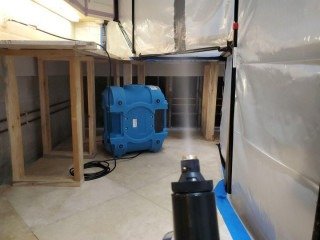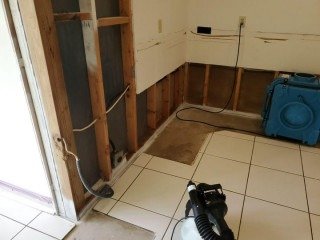Professional Mold Remediation Services
Don't Let Toxic Mold Put Your Family's Health at Risk
Stop mold damage before it spreads. Call now for a free, no-obligation estimate from a local remediation expert.
Free Estimate · Zero Obligation · Available 24/7
What Is Mold Fogging and How Does It Work?
Mold fogging is the process of releasing a fine mist of antimicrobial or fungicidal solution into the air to kill airborne mold spores and settle them onto surfaces. Some call it a "mold bomb." It sounds high-tech—and it kind of is—but is fogging enough to solve a mold problem?
The short answer: Fogging can be helpful, but it’s not a cure-all.
In this guide, you'll learn:
- How mold fogging works
- The difference between wet fogging and dry fogging
- Whether fogging is safe (for your home and your health)
- When fogging makes sense—and when it doesn’t
- Why killing mold isn’t enough (removal is key)
- Who should handle fogging (and how to do it properly)
🧪 How Does Mold Fogging Work?
Mold spores become airborne easily, especially during cleaning or remediation. Mold fogging works by releasing an atomized mist of antifungal solution into the air. This mist kills airborne spores by disrupting the mold's cell membranes. The dead spores then fall to the ground or surfaces, where they should be HEPA vacuumed up.
“Dead mold may still cause allergic reactions in some people.”
— EPA Mold Basics
But fogging doesn’t remove mold that's embedded in porous materials like drywall, insulation, or wood. And it doesn’t fix the moisture source that allowed mold to grow in the first place.

🌫️ Types of Mold Fogging
There are two primary types of fogging:
1. Wet Fogging
Uses a traditional fogging machine to emit a fine mist. It can reach hard-to-access areas like behind cabinets or in attic corners. Best used in dry environments or when materials aren't moisture-sensitive.
2. Dry Fogging
Uses an ultra-fine vapor (less than 15 microns) that doesn’t wet surfaces. This method allows better penetration into tight crevices. Dry fogging is often promoted by remediation companies as a “no-removal” solution—but that’s controversial (more on that later).
⚠️ Is Mold Fogging Safe?
It can be—if done correctly.
- The product must be EPA-registered for mold remediation.
- Avoid foggers using harsh or unapproved chemicals.
- Wear proper PPE: gloves, goggles, N95 (or better) respirator.
- Fogging should never be done with people or pets present.
- Open windows and run fans afterward for ventilation.
“Inhalation of certain fogging agents like hydrogen peroxide can cause respiratory irritation.”
— CDC NIOSH Guidelines

🧱 Why Fogging Alone Is NOT Enough
Mold embeds itself into porous materials and develops root-like structures called hyphae. Fogging kills spores, but not hyphae. If you only fog and don’t remove affected materials or eliminate the moisture source, mold will come back.
“You must clean up the mold and fix the water problem. Otherwise, the mold problem will likely come back.”
— EPA
Mold fogging is not a substitute for proper remediation.
Problems with Fog-Only Companies
Some remediation companies now promote fog-only services as a cheap alternative. Yes, it may temporarily improve air quality—but dead spores can still cause reactions and become airborne again later. That’s why industry standards from the IICRC don’t consider fogging a standalone solution.
🛠️ Who Should Fog for Mold?
DIY fogging is risky. Use a certified mold professional who:
- Follows IICRC S520 standards
- Uses EPA-approved solutions
- Does proper source removal before fogging
- Offers air quality testing before and after
🔧 How to Use Mold Foggers
If you're fogging (professionally or DIY), here are tips:
- Prep the room: Cover electronics, remove paper goods.
- Use the right fogger: Dry foggers <15 microns, wet foggers <50.
- Don’t overdo it: Run fogger for 2–3 minutes max.
- Let it sit: Allow 30+ minutes of dwell time.
- Ventilate: Open windows and use fans after treatment.
- Clean up: Use a HEPA vacuum to remove dead spores from surfaces.

✅ When Does Mold Fogging Make Sense?
Fogging can be effective:
- After source removal to kill airborne mold
- For hard-to-reach areas like HVAC ductwork or crawlspaces
- To supplement a full remediation plan
But it should never be your only step.
🧼 What to Use Instead (or In Addition)
- HEPA vacuums for dead spores
- Antimicrobial wipes for surface treatment
- Material removal if drywall, insulation, or wood is damaged
- Fix leaks, improve ventilation, and reduce humidity (under 60%)
🧾 Final Thoughts
Mold fogging is not a scam—but it's not a miracle either.
Use it to complement proper mold remediation, never replace it. If you only fog and don’t fix the moisture problem or remove the mold, it’s going to come back. Guaranteed.
When in doubt? Bring in a licensed mold assessor (like me!) and get the facts before you fog.
🧠 FAQ
Is mold fogging safe around pets or kids?
Only after the home has been fully ventilated and dried. Never fog while pets or people are present.
Can I fog to fix black mold?
No. Black mold like Stachybotrys chartarum must be physically removed and requires professional remediation.
How long does mold fogging last?
If you fix the moisture issue and clean up properly, fogging can help long-term. If not, the mold will return.
Does fogging remove musty odors?
Yes, temporarily. But if the root problem isn't fixed, the smell (and the mold) will return.
Explore Related Topics:
Notice an update we should make?
We strive for accuracy. Contact us here if you see incorrect or outdated info on this page.
